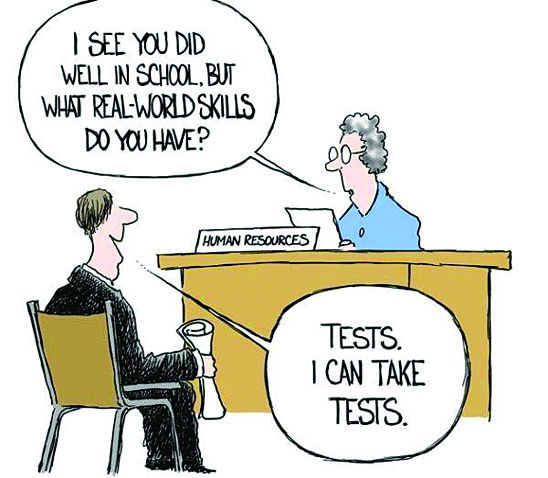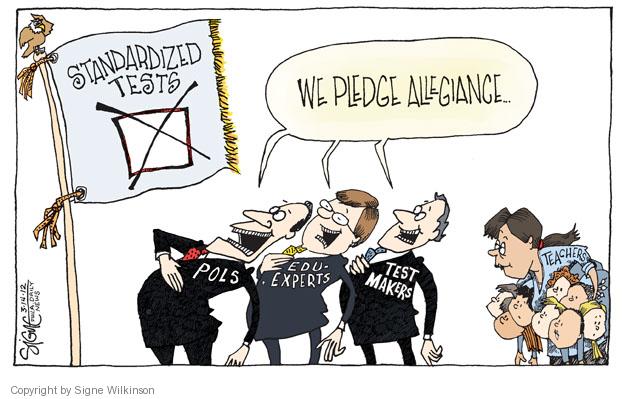Larry Cuban on School Reform and Classroom Practice: Whatever Happened to Authentic Assessment?
No Child Left Behind drove a stake into its heart. OK, that is a bit dramatic but the standards, tests, and accountability movement that began in the early 1980s, picking up speed in the 1990s, then accelerating to warp drive with the passage of NCLB brushed aside this Progressive instructional reform called “authentic assessment.”* Pick your metaphor but, save for scattered teachers across America who began teaching during the height of “authentic assessment,” few new superintendents, novice principals, and rookie teachers, much less reform-minded parents have ever heard of this Progressive way of assessing student learning.

Where and When Did Authentic Assessment Originate?
In the 1980s following A Nation at Risk report state policymakers rushed to raise curriculum standards and increase school and district accountability. One outcome of these cascading reforms across the country was a sharp increase in students taking required standardized tests. By the late-1980s and early 1990s, Progressives* of the day such as Deborah Meier, Grant Wiggins, Fred Newmann, Linda Darling Hammond, and Ted Sizer sought to make schooling more demanding of students intellectually in tasks, activities, and assessments. Meier, Sizer, and others, for example, created and organized schools with teachers who pushed students to not only think about the content and skills they learned in ways that went well beyond what multiple-choice items on a standardized test would capture but also to demonstrate to others through portfolios and performance tasks–what they learned and apply that learning to the world in which they lived. “Authentic assessments” became an often-mentioned instructional reform. The phrase “performance assessment” was also used interchangeably with “authentic assessment.”
What Problems Did Authentic Assessment Intend To Solve?
Coming in the wake of the increased standardized testing and the narrowing of the curriculum to those tested subjects–reading and math–learning ,especially in poor and minority schools, was reduced to covering what would be on the tests and repetitive tasks. Standardized tests are limited severely in what they measure of student learning, much less performance. Yet policymakers looked to these tests as accurate measures of student outcomes. Finally, students were disengaged and often reduced to passivity. Seeing such a backwash of problems from mandated testing, instructionally-driven reformers saw authentic assessment (no more quote marks for rest of post) as a way to return teaching and learning to its Progressive roots of engaging students through connecting content and skills to real world tasks thereby increasing student participation in learning (see here and here).
What Does Authentic Assessment Look Like in Classrooms?
I could not find a teacher’s lesson or student description of authentic assessment in print. There may be such descriptions but I found none. What I did find after many searches were video clips of schools committed to authentic assessment and a third grade teacher describing what she did with English Language Learners (see here, here, and here).
I was surprised by this dearth of sources describing what actually occurs in classrooms. Designing and applying authentic assessment tasks in a classroom lesson and unit of instruction takes a lot of work by teachers. True, all of the work is front-loaded the first few times but the assessment can be used often afterwards. There are shortcuts, of course, in designing such assessments and locating tasks for students to perform. Nonetheless, much time is involved in finding the right real-world task that captures the student learning outcome that the teacher seeks to assess. I apologize to readers for not having such examples.**
Perhaps I looked in the wrong places or was not persistent enough. If readers know of descriptions of actual classroom lessons that eluded me, please send me the links.
Did Authentic assessment Work?
Here is the bind that champions of authentic assessment find themselves in. If “work” means effectiveness in determining whether students have learned the required content and skills and performed satisfactorily on mandated state tests, to what degree has authentic assessment aided in the outcome.Simply put, here is the bind. Does a classroom teacher or the principal of school committed to authentic assessment through student portfolios look to scores on state standardized tests as evidence of learning? Or does the teacher, school, or district design different measures that would determine the extent that students learned? Or do both matter?
Answers to the questions pose a contradiction since state tests are limited measures of student learning of content and skills that fail to grasp the critical skills gained from assessing discrete tasks authentically. The answer to the other question is “yes” which means an enormous investment in time from teachers and others, a calculation that both teachers and administrators have to make, given the other demands upon teachers during the school day.
When the state of Vermont, for example, adopted portfolios as an authentic assessment rather than standardized tests, RAND researchers evaluated whether portfolios supplied sufficient and accurate data on student performance. They concluded that the data they collected was less in quality than traditional standardized test scores.
What Happened to Authentic Assessment?
Like many Progressive additions to teachers’ repertoires over the decades, the excitement surrounding its introduction in the late-1980s and early 1990s waned. The idea of teachers and schools designing assessment tasks that capture whether students can apply what they have learned, of course, continues to appear in many teachers’ lessons within the nation’s 100,000 schools. Teachers have constantly blended traditional and Progressive ways of teaching and learning over the decades. But the boosterism and hoopla surrounding authentic assessment have disappeared. Standardized tests remain the gold standard in 2020 for assessing student learning.

*I use the word Progressive to describe authentic assessment since it is aimed at the principle of children learning by doing and engaging student’s attention and participation in real world tasks. These were the aims of the early 20th century Pedagogical Progressive and current educators committed to constructivist teaching and learning.
**Please see comments from readers who recommended sources that I have not included. Especially Bob Lenz’s comments and the links he provides to current performance assessments. Thank you, Bob.
This blog post has been shared by permission from the author.
Readers wishing to comment on the content are encouraged to do so via the link to the original post.
Find the original post here:
The views expressed by the blogger are not necessarily those of NEPC.
